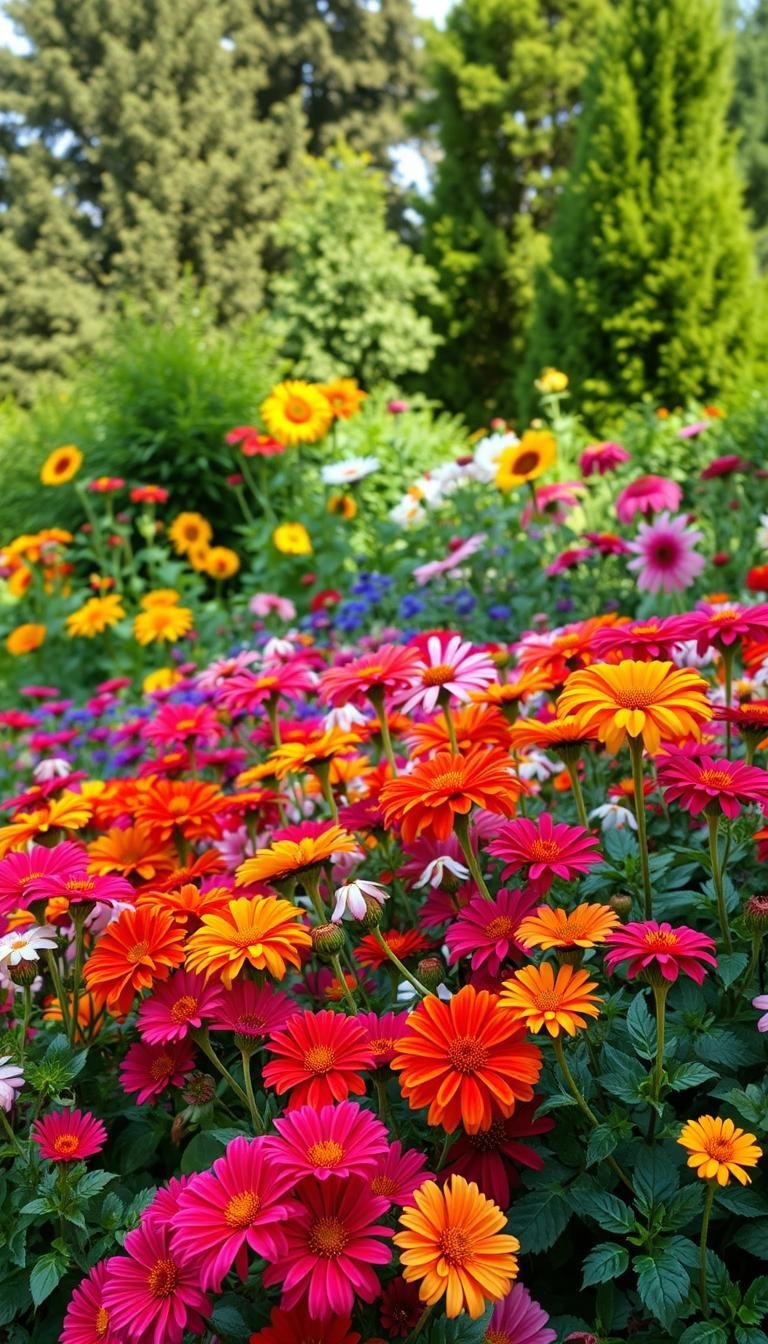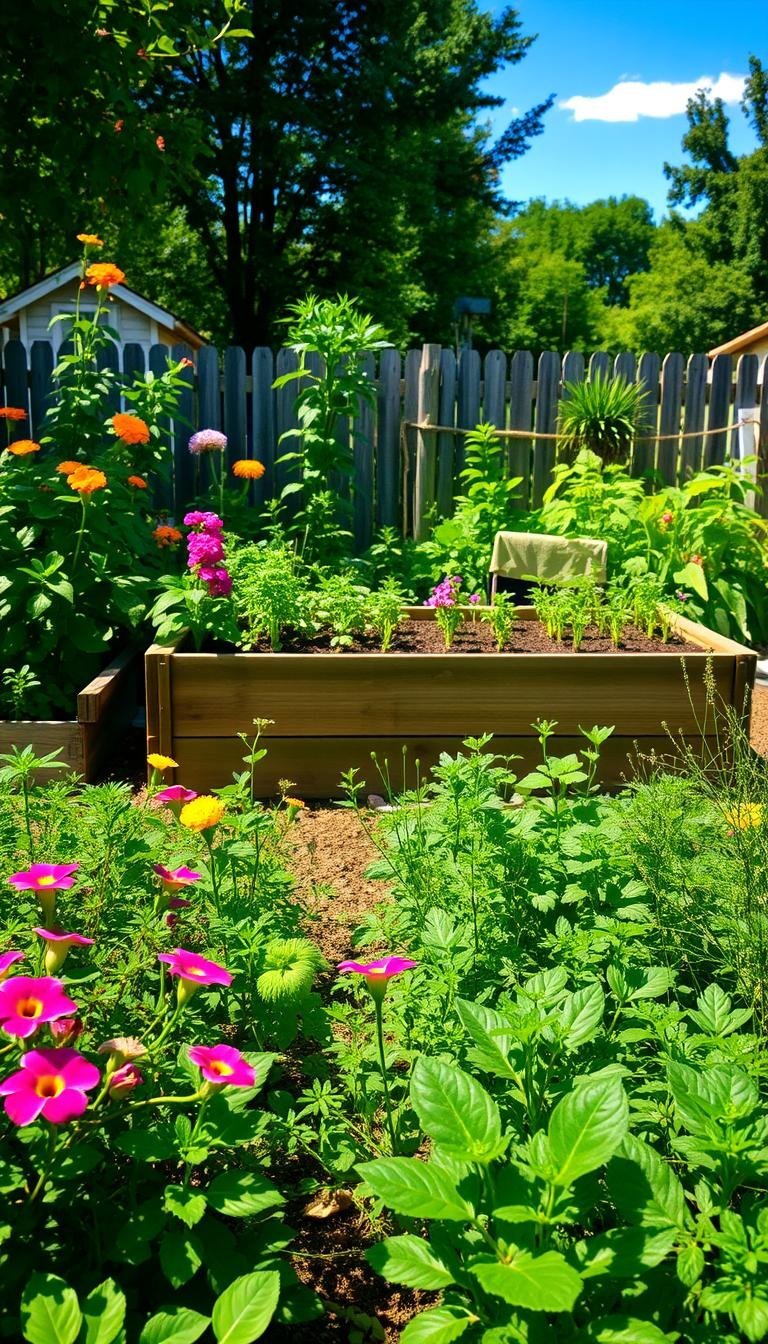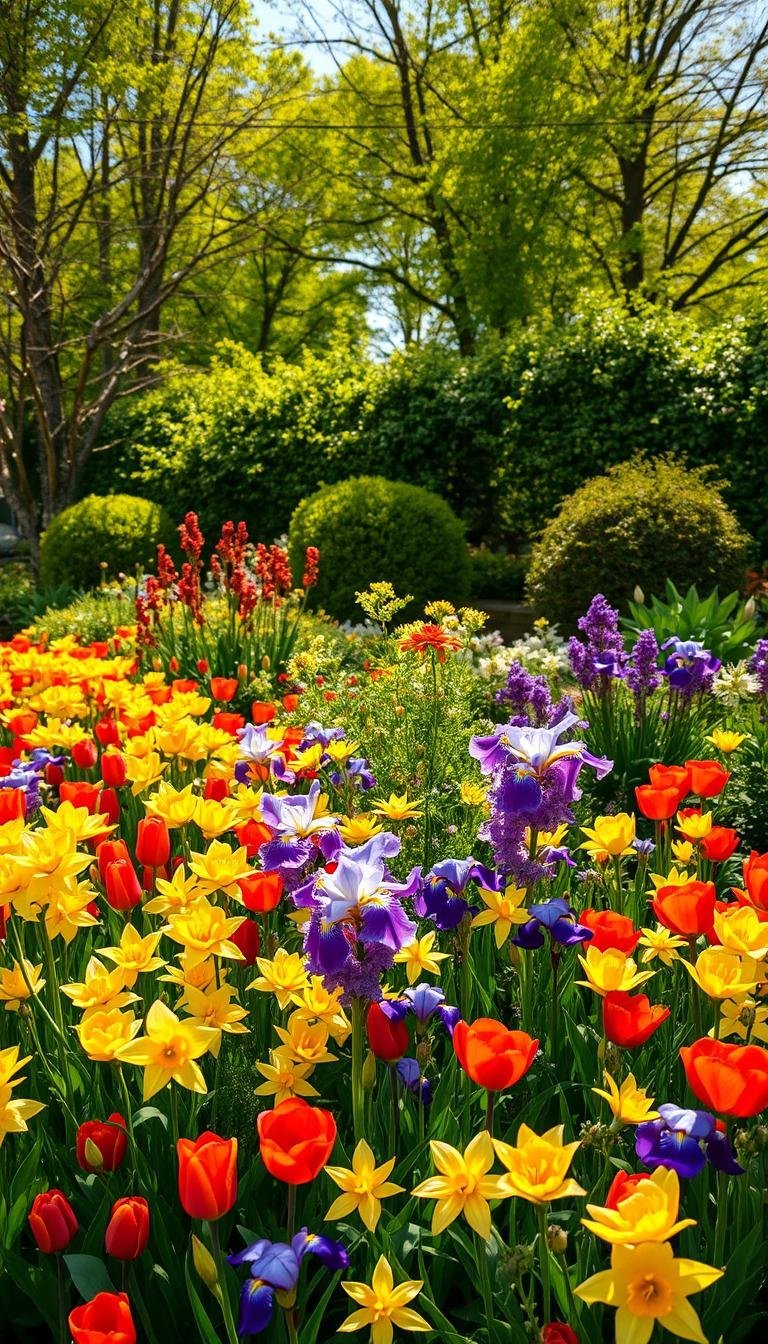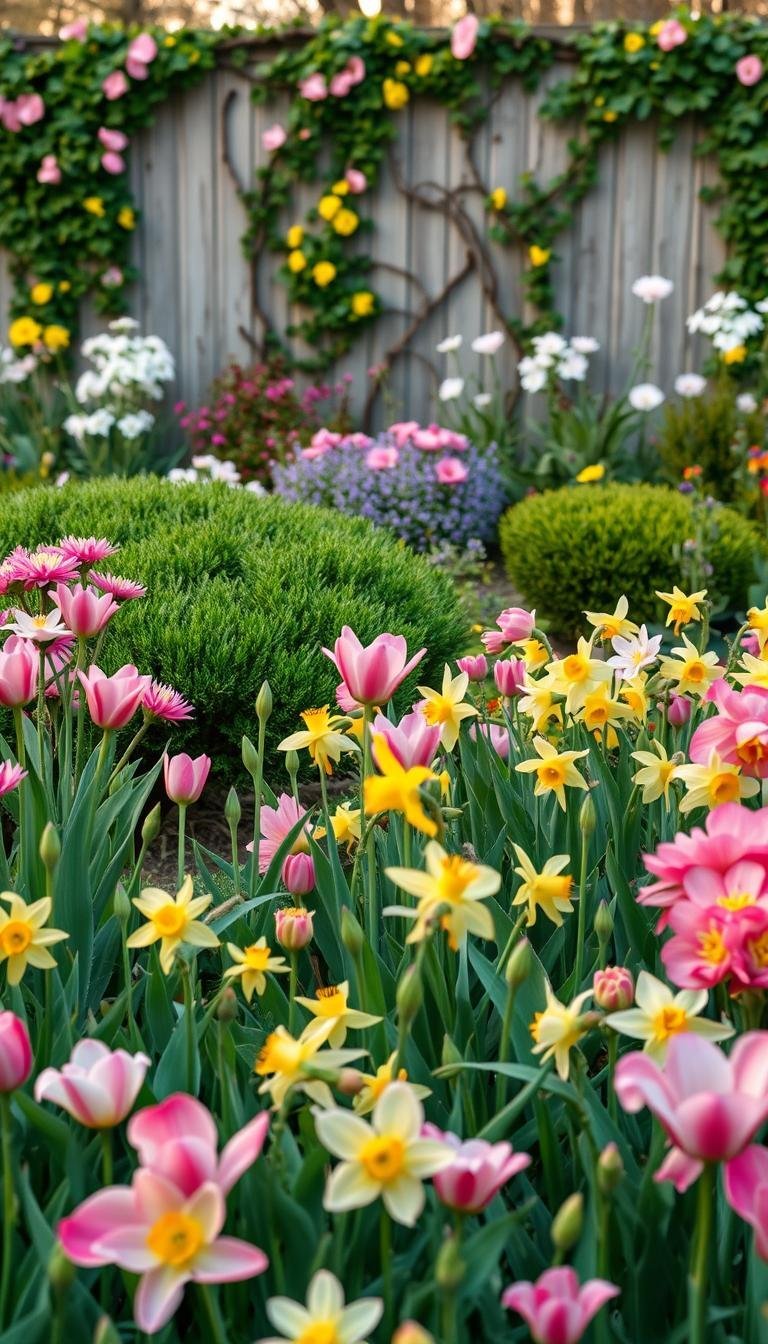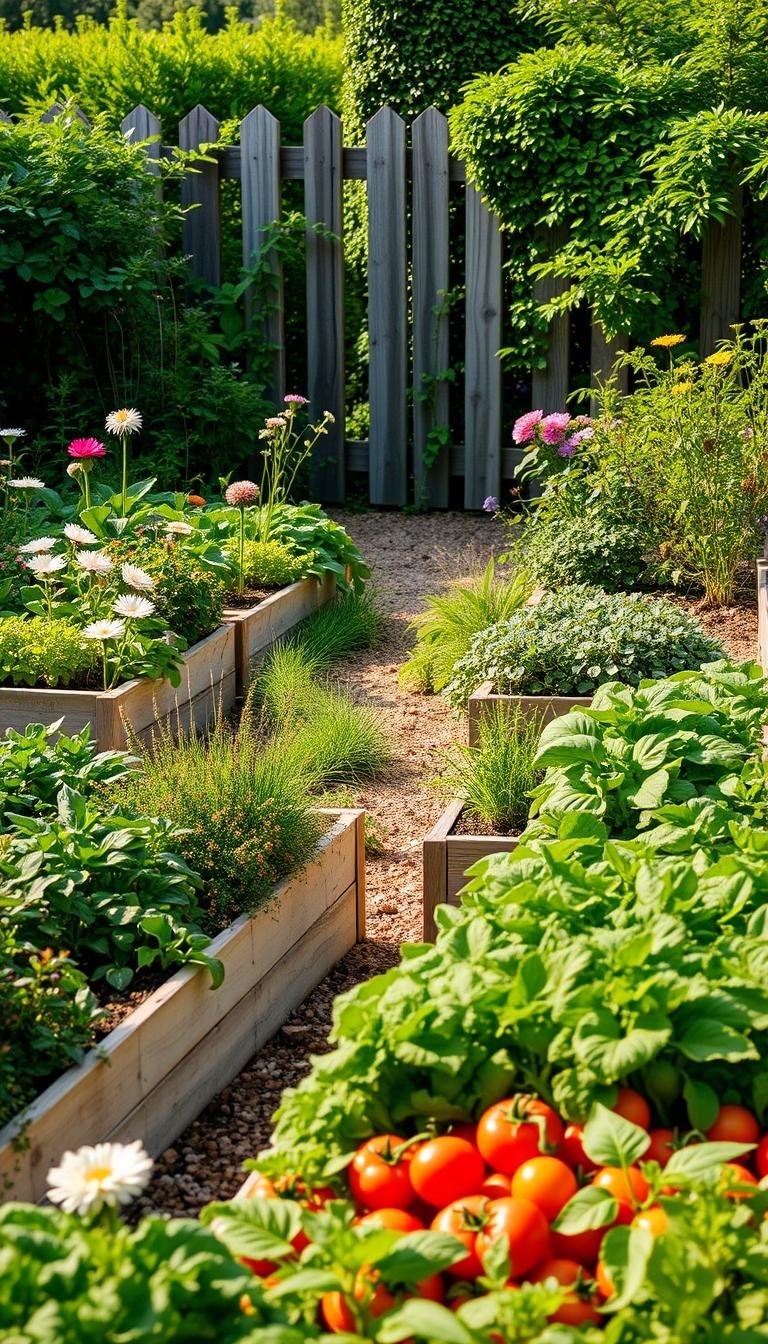This post may contain affiliate links. If you click and buy, we may earn a small commission at no extra cost to you. Learn more.
Bulb flowers are a gardener’s secret to vibrant, low-maintenance beauty. They thrive in many US climate zones. From tulips to daffodils, they bring color year after year.
Both beginners and expert gardeners love bulb flowers. They are easy to care for and make a big impact. Planting them turns small spaces into colorful displays.
Learn how to pick the right bulbs for your area. Find out how to plant and care for them. Discover creative ways to mix bulbs with other plants for stunning landscapes. Let’s make your garden bloom!
Contents
- 1 Understanding Bulb Flowers and Their Varieties
- 2 Choosing the Right Bulb Flowers for Your Garden
- 3 Preparing Your Garden for Bulb Planting
- 4 Planting Bulb Flowers: A Step-by-Step Guide
- 5 Caring for Bulb Flowers During Their Growth
- 6 Common Pests and Diseases Affecting Bulb Flowers
- 7 Harvesting and Maintaining Bulb Flowers Post-Bloom
- 8 Creative Uses for Bulb Flowers in Landscaping
- 9 Inspiring Bulb Flower Combinations for a Vibrant Display
Understanding Bulb Flowers and Their Varieties
Bulb flowers are more than just spring blooms—they’re nature’s storage systems. To grow them well, start by knowing what makes a bulb a bulb. These underground structures store energy, but not all are true bulbs. Let’s break it down:
What Are Bulb Flowers?
Botanically, true bulbs are nutrient-packed storage organs. Think of a tulip’s layered “onion-like” structure. But many gardeners group similar structures under the term “bulb types.” Here’s the breakdown:
- Bulbs: Solid, rounded structures (e.g., tulips, daffodils).
- Corms: Swollen stems (e.g., crocus).
- Tubers: Fleshy, enlarged stems (e.g., cyclamen).
- Rhizomes: Horizontal stems (e.g., lily of the valley).

Popular Types of Bulb Flowers in the US
American gardens thrive with these favorites:
- Tulips: Bold colors, spring-blooming.
- Daffodils: Deer-resistant, early spring stars.
- Hyacinths: Fragrant clusters for containers or borders.
- Lilies: Tall, showy blooms in summer.
- Alliums: Globe-shaped heads add architectural interest.
Unique Features of Each Variety
Each bulb type has its quirks:
Bloom times: Tulips signal spring; lilies wait until summer. Height: Alliums tower, while crocus stay low. Care needs: Daffodils multiply easily, while lilies prefer well-drained soil.
Knowing these details helps match bulb types to your garden’s conditions and goals. Start by choosing varieties that align with your space’s light, soil, and bloom-time preferences.
Choosing the Right Bulb Flowers for Your Garden
Starting with spring bulbs is a smart way to fill gardens with color. But how do you pick varieties that thrive in your area? Let’s break down the steps to find flower bulbs that fit your space and climate.

Factors to Consider for Selection
- USDA Zones: Match your region—e.g., tulips suit USDA zones 3-8, while snowdrops tolerate cold Northeast winters.
- Sunlight Needs: Daffodils prefer full sun; spring bulbs like hyacinths thrive in partial shade.
- Soil Drainage: Avoid waterlogged soil. Use raised beds if needed.
- Bloom Timing: Pair bulbs with existing plants to create color waves.
Seasonal Bulb Flowers for Year-Round Color
- Spring: Crocus, snowdrops, and tulips bloom March-May. These flower bulbs signal the start of the growing season.
- Summer: Try lilies or alliums for June-July color.
- Fall: Colchicum and autumn crocus add late-season drama in August-October.
Plan blooms across seasons by mixing spring bulbs with later-blooming types. Start with tried-and-true options like Dutch tulips or hardy daffodils. Your local nursery or extension service can help tailor choices to your region’s climate. With these tips, you’ll create a garden that blooms from first frost to first snow.
Preparing Your Garden for Bulb Planting
Before you start planting, a bit of prep work is key. First, check your soil and drainage. These are critical to avoid early problems.
Ideal Soil Conditions for Bulb Flowers
Bulbs need soil that drains well but is also rich in nutrients. Loamy soil with compost or leaf mold is best. Use home kits to test soil pH; aim for 6.0–7.0.
If you have heavy clay soil, like in the Midwest, add perlite to make it looser. Coastal gardeners with sandy soil should mix in peat moss to keep it moist. Don’t overdo it with amendments; make small changes gradually.
Importance of Drainage in Bulb Planting
“Poor drainage is the number one killer of bulbs,” says landscape expert Sarah Greenfield. “Even a little standing water can rot roots within days.”
- Test drainage by digging a 1-foot hole, filling it with water, and timing drainage. If it drains less than 1 inch per hour, improve drainage.
- Raised beds solve soggy spots. Build 12-inch-high frames filled with sandy loam.
- Plant bulbs on slopes or mounds to encourage water runoff.
To improve drainage, add grit or gravel to planting holes. This helps without messing with the soil layers. Follow these steps for a successful planting bulbs and lasting bulb gardens.
Planting Bulb Flowers: A Step-by-Step Guide
Follow this bulb planting guide to master the art of planting bulbs for thriving blooms. Timing and technique make all the difference in ensuring your garden thrives.
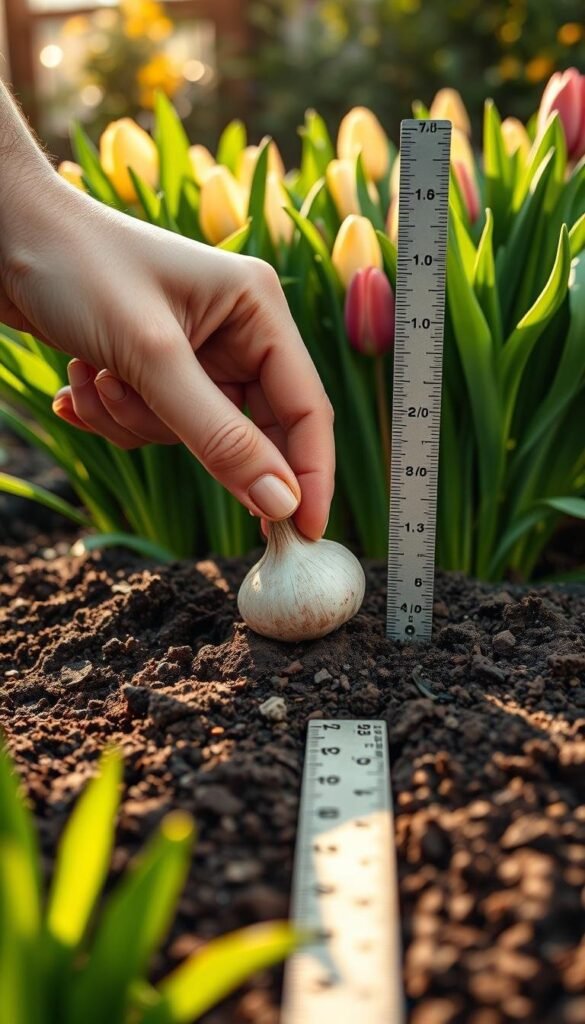
Timing Your Planting: Fall vs. Spring
In the planting bulbs process, timing depends on your region. Most spring bloomers like tulips and daffodils are planted in fall, 6-8 weeks before the first frost. For summer and fall-blooming varieties such as crocus or autumn crocus, spring planting is best. A quick reference:
- Fall zones: USDA Zones 3-7 plant in September-October
- Spring zones: Zones 8-10 plant in January-March
“Planting at the right time ensures roots establish before dormancy,” advises the National Garden Bureau.
Proper Depth and Spacing for Bulbs
Depth matters: bury bulbs 2-3 times their height. Use this rule of thumb:
| Bulb Type | Depth |
| Tulips | 6-8 inches |
| Crocus | 3-4 inches |
Space bulbs 2-4 inches apart for natural clusters. Try layering (or “bulb lasagna”) by planting late-blooming bulbs like daffodils deep, then adding shallower planters like grape hyacinths above. This creates a season-long show without overcrowding.
Follow these steps for a garden that dazzles. Happy digging!
Caring for Bulb Flowers During Their Growth
Understanding bulb care is key to their growth. Proper watering and fertilizing help them thrive. This ensures they bloom year after year.
Watering Needs for Healthy Growth
Watering changes with each growth stage. New bulbs need a good soak to settle. But, don’t let them get too wet.
When shoots come up, water them once a week if it’s dry. Keep the soil moist during blooming to make flowers last longer. Cut back on water when leaves turn yellow.
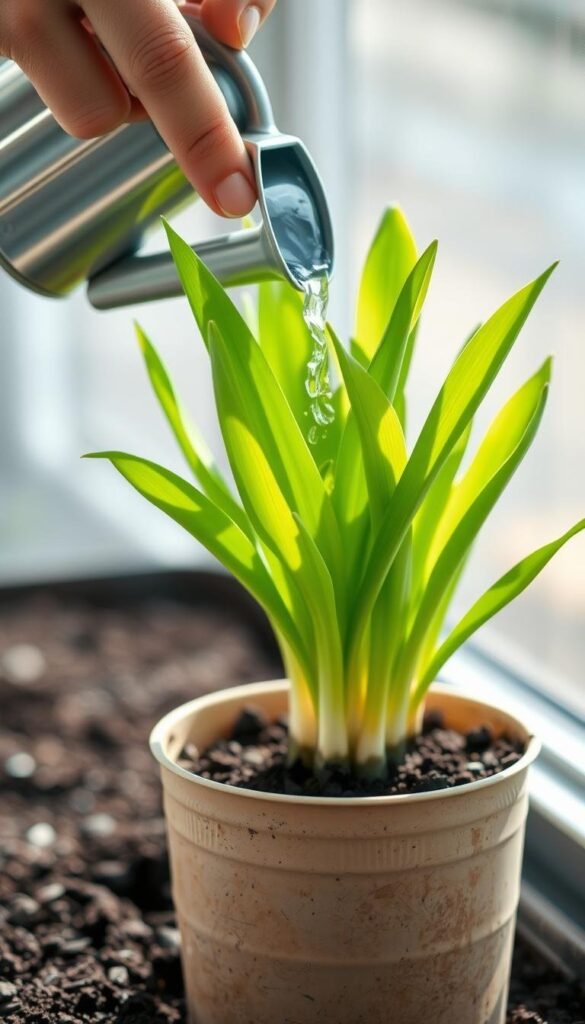
The right amount of water varies by region. Dry areas might need drip irrigation. Wetter places might not need summer watering.
Fertilizing Tips for Vibrant Blooms
Feed bulbs wisely. Use a balanced fertilizer when planting. Then, switch to a phosphorus-rich one like 5-10-10 in early spring. This helps roots and flowers grow.
Don’t use too much nitrogen, as it makes leaves grow more than flowers. Fertilize 6 inches from the stem to avoid burning. Organic gardeners can use compost or bone meal.
Changing how you water and feed bulbs can make them stand out. Check the soil often and fertilize at the right time for lasting colors.
Common Pests and Diseases Affecting Bulb Flowers
Bulb flowers can face threats from pests and diseases, even with good care. Spotting and stopping these problems early keeps your garden bright. Quick action is vital to protect your flowers.
Identifying Common Pests
Squirrels, chipmunks, and voles might dig up your bulbs. Deer could eat the tender shoots. Insects like bulb mites, thrips, and nematodes can harm plants from below.
Look for chewed leaves, wilted stems, or yellowing foliage. Coastal gardeners might deal with slugs. Western areas have gophers. In humid places, fungal issues like tulip fire need attention.
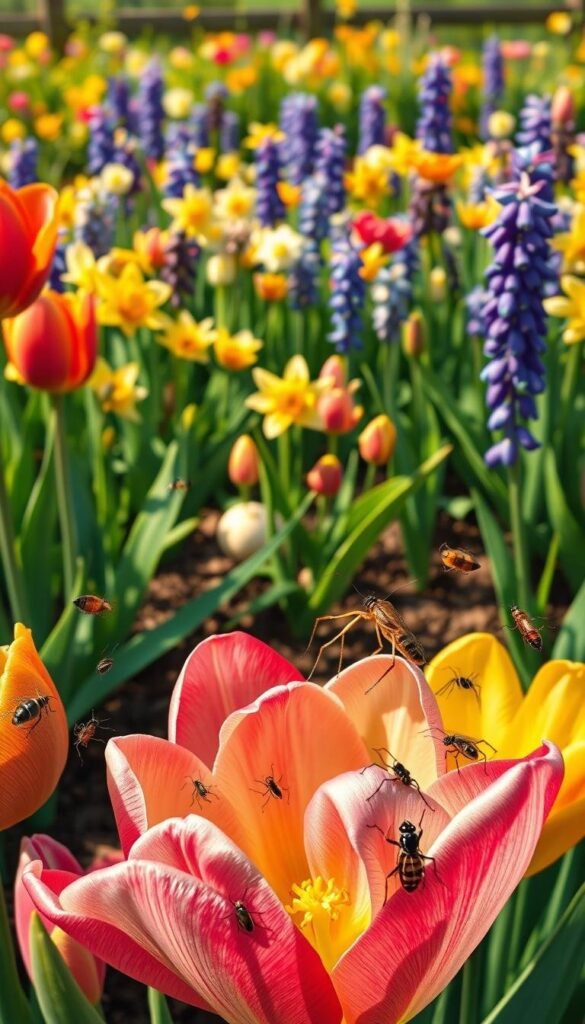
Preventative Measures
Here are ways to protect your bulb flowers:
- Physical barriers: Lay wire mesh over planting areas to deter digging animals.
- Repellents: Use blood meal or scent deterrents to keep deer and rodents away.
- Companion planting: Intersperse daffodils or alliums; their scent repels some pests.
- Soil care: Rotate planting spots yearly to avoid disease buildup.
For disease prevention, space bulbs widely to improve airflow. Water at soil level to reduce fungal growth. Organic neem oil or copper-based sprays can combat insects without harming beneficial pollinators.
Regular soil testing helps catch issues early. This ensures your bulb flowers stay healthy season after season.
Harvesting and Maintaining Bulb Flowers Post-Bloom
After the blooms fade, it’s time to care for your bulbs. This ensures they come back stronger next year. Follow these steps to keep them healthy and ready for planting.

When and How to Deadhead Bulbs
Deadheading stops bulbs from wasting energy on seeds. Use clean shears to cut off faded flowers just below the stem. Never cut back green foliage until it’s fully yellow. This green part helps the bulb grow.
Tulips and daffodils do best with this care.
“Leaving foliage until it’s fully yellow is the key to strong bulb care,” says the American Bulb Society.
Storing Bulbs After the Growing Season
- Wait until foliage dies back, then gently dig up tender bulbs like dahlias or gladiolus.
- Brush off soil, air-dry them for 2-3 weeks in a shaded, well-ventilated area.
- Store in mesh bags filled with peat moss in a cool (40-60°F), dark location—like a basement or garage.
In USDA zones 8-10, some bulbs (like amaryllis) can stay in-ground. Label stored bulbs with variety and planting date for next year’s planting bulbs. Check monthly for rot or mold—discard affected bulbs immediately.
Creative Uses for Bulb Flowers in Landscaping
Make your outdoor area pop with bulb arrangement ideas. Whether it’s for bulb gardens or adding a splash to small spots, these plants are full of design options. Turn simple areas into vibrant scenes with the right planning and creative spots.
Designing Stunning Flower Beds
Begin by sketching out bulb arrangement plans. Try drift planting for a natural look, like bluebells under trees. Mix tall alliums with shorter crocus for height. Plan blooms to overlap for ongoing color. Here’s how to plan for your area:
- Coastal climates: Use drought-resistant alliums with snowdrops.
- Mountain regions: Mix crocus and scilla in rocky soil.
- Urban spaces: Compact tulips like ‘Little Beauty’ work well in city beds with mulch.
Incorporating Bulbs into Containers and Hanging Baskets
Containers offer new chances for small areas. Pick dwarf types like muscari or paperwhites for pots. For winter beauty, force bulbs in glass vases indoors. Here’s how to do it right:
- Match bulbs with annuals, like tulips with pansies for contrast.
- Use gravel for drainage; repot in fall for spring blooms.
- Hang baskets of grape hyacinths near doors for spring color.
Be bold! Bulbs fit any style, from formal to wildflower meadows. Your bulb gardens can be a canvas for creativity all year.
Inspiring Bulb Flower Combinations for a Vibrant Display
Creating a stunning garden with spring bulbs is more than just planting. Bulb arrangement turns simple spaces into vibrant displays. Pairing bulbs with colors and textures that match makes your garden a masterpiece.
Color and Texture Pairings for Maximum Impact
Color theory makes displays pop. Try pairing purple tulips with yellow daffodils for a bold look. Soft colors like pink tulips and lavender hyacinths create a beautiful gradient.
Monochromatic schemes, like white aconites and narcissus, bring elegance. Mix spiky alliums with round crocus blooms for texture. These pairings make spring bulbs stand out.
Combining Bulbs with Other Plant Types
Blend bulbs with perennials like hostas for year-round interest. Plant crocus under shrubs or pair alliums with lavender for fragrance. Use annuals like sweet alyssum to fill gaps.
As spring goes on, let perennials like peonies cover fading bulb foliage. This keeps your garden looking great all season.
Don’t be afraid to try new things—your garden’s look and climate guide you. Whether you prefer formal bulb arrangements or casual spring bulbs drifts, aim to show off your style. Let these ideas inspire you to make every part of your garden a colorful story.
To bring you cozy inspiration more efficiently, we sometimes use AI to assist in content creation — but every word and idea is carefully shaped by our team. See our AI Disclosure for more info.


